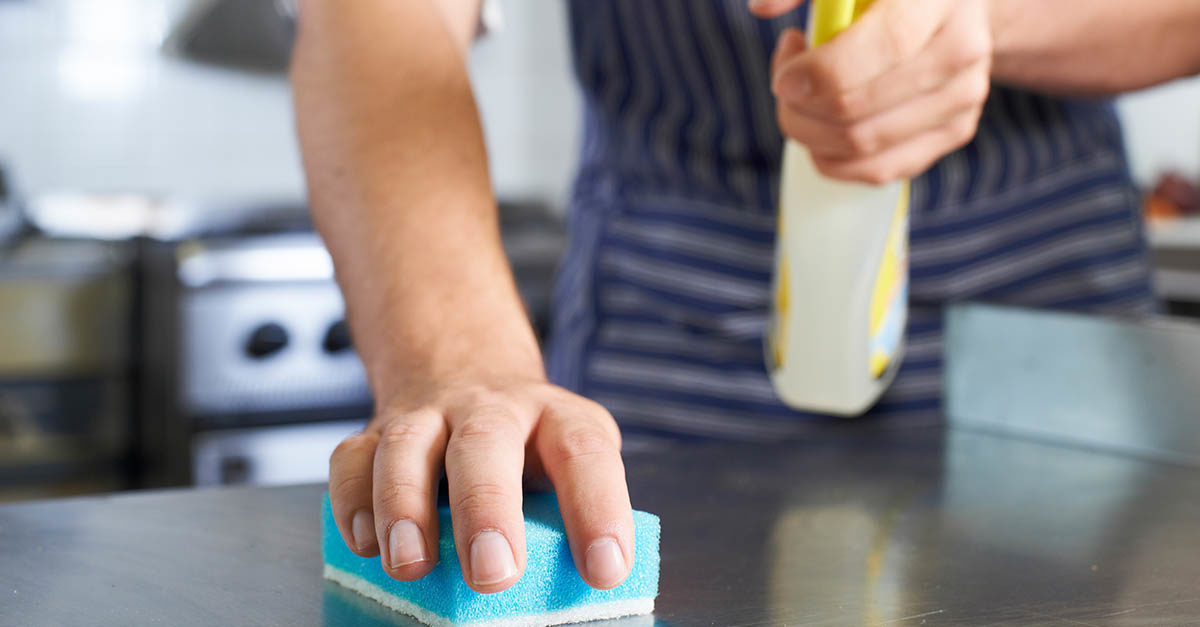To maintain good hygiene ratings and excellent customer satisfaction, a high standard of cleanliness is key in a commercial kitchen. According to the Centers for Disease Control and Prevention, more than 50% of foodborne outbreaks are linked to restaurants—making it essential to uphold cleanliness on a daily, weekly, and monthly basis.
Let’s discuss some smart tips for cleaning a commercial kitchen so that your establishment conforms with all health and safety regulations. From products to use on kitchen surfaces to make them shine to daily maintenance tips that help commercial equipment stay clean longer, these tips will keep the kitchen hygienic from breakfast to dinner.
1. Encourage Employees to Wipe as They Work
Kitchen countertops are notorious magnets for bacteria growth. Grease and dirt will naturally build up over time, so these surfaces must be cleaned regularly and thoroughly. If worktops aren’t cleaned properly, they become a haven for microbes—particularly in a warm environment. And since these surfaces are used for food preparation, your kitchen can become quite an unhygienic place if not sufficiently maintained throughout the day.
For light daily cleaning, confirm that staff are trained to remove all items, including storage bins and cutlery, from the surfaces, and ensure that those responsible for cleaning apply a disinfectant spray and wipe down the entire area. Spray the disinfectant approximately 12 inches away from the surface and let the surface dry before replacing the removed items.
To prevent your employees from forgetting any essential maintenance, create a checklist of daily tasks specific to the kitchen area. This list should include cleaning work surfaces, emptying the dishwasher, and disinfecting the sink and oven. Following this checklist is an effective way to reduce hygiene failure.
See to it that flooring is cleaned daily. To do so, implement the mentality that floors must be swept thoroughly, including corners and underneath appliances to catch all crumbs. For more stubborn areas, encourage cleaning professionals to use a deep-bristle brush to remove stains and long-standing spillages. Making this cleaning activity part of the daily routine by teaching it through training will ensure that your commercial kitchen achieves high food-hygiene ratings.
2. Assign Sections to Different Staff
Consider splitting the responsibility for the tasks on your daily checklist by kitchen area. Designate specific areas as the responsibility of different employees and, for the best results, communicate to those employees that surfaces should always be cleaned directly after an incident has occurred in the area.
For thorough dishwasher sanitation, ensure that those assigned with loading and emptying the dishwasher know that it should always be set to a high temperature. Particularly grimy items should be rinsed before being placed in the dishwasher for a high-strength clean that avoids stains. If dishwashers are not cleaned adequately, they are at risk of clogging, which leads to ineffective subsequent cleans and poor hygiene levels.
A kitchen sink can become a refuge for germs, especially if it isn’t regularly rinsed and is often exposed to germs and bacteria. All-purpose cleaner or disinfectant effectively kills germs in sinks; however, residual heavy grease or oil can cause blockages, impacting draining power and the sink’s longevity. This makes it essential to appoint employees who will take care of this cleanup process.
3. Perform Monthly Deep Cleans
To avoid breakdowns, plan preventative kitchen maintenance. While some areas of the kitchen won’t need daily maintenance, scheduling professional cleaning time will keep these areas from turning into a hygiene nightmare.
The refrigerator is a critical appliance to include in the monthly deep clean routine. Empty all food items from the fridge before cleaning, and then check all shelves and drawers for spillage or residue. Clean all shelves and drawers with soapy water to leave them sparkling and ready for food storage. From there, spray every remaining area with disinfectant, including the handles and doors, which harbor germs.
With regular maintenance, commercial kitchen cleaning doesn’t have to be a difficult or time-consuming task—it’s all about staying on top of things. Ensuring that good cleaning policies are followed will leave customers satisfied with their experience in your facility, which leads to greater return on investment and keeps your business competitive within its market.



